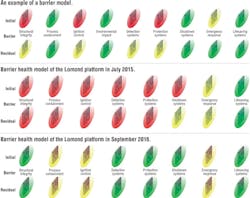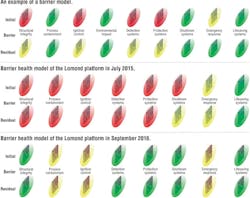Technology integrator software improves process safety management
Scot Rudolph
RiskPoynt
For offshore oil and gas managers, risk management - specifically process safety management (PSM) - continues to be a major concern. These challenges in the current low oil price environment have introduced a set of influential conditions that present significant concerns for leadership in their team’s ability to effectively evaluate and manage major accident event or hazard (MAE/MAH) risks. Historically, whenever challenges arose, the solutions included prompt and robust capex and dedication of people to mitigate the risk to their people and their assets.
At $40-50/bbl oil, both money and people are in short supply today and the impacts to the bottom line and maintaining production pose potentially conflicting priorities. To better quantify the full extent of human resource losses, there have been more than 351,000 jobs cut by oil and gas producers worldwide. Add that to the fact that oil has yet to reach the long-anticipated and hoped for price of $60/bbl, and you have an industry that is averse to any type of expenditure that could be viewed as discretionary. Some experts predict that by the time OPEC’s self-imposed production cuts end, the existing surplus may not have been substantially reduced due to depressed consumption, thus prolonging the current uncertainties in pricing. With the strength in US shale oil production and increase in OPEC production in the foreseeable future, long-term price volatility, at a minimum, seems likely. Risk, specifically MAE/MAH risks to offshore facilities and assets remain constant. The low prices, high overhead and complicated nature of managing PSM risks are as great as ever. So, it would appear that the risk management challenge continues to pose a serious problem without solution - or does it?
Fortunately, while the tides of fortune have ebbed in the oil and gas industry, advancements in integrated technology have flowed at an accelerated pace. This bounty in the technology market provides the offshore oil and gas industry with solutions to some of its most pressing concerns regarding MAE/MAH. Most notably, integrated technology tools and systems have been developed that enable offshore operators and explorers to view the effectiveness and health of their MAE/MAH safety barriers in real time, as compared to an annual study or review. The evolution of process safety management has included a veritable kelp forest of processes to identify, qualify, and even quantify risk. They include qualitative risk analysis, risk registers, “Bowties,” HAZOPS, HAZIDS, LOPA analyses, enterprise computer software programs for workflow management, specialized software programs to manage maintenance, control of work, permitting, safety critical equipment registers, etc.; not to mention safety management system requirements in the form of procedural (administrative) controls.
For operational personnel, the complexity and sheer volume of this information presents them with challenges in understanding and interpreting the sheer volume of data, most of which is static and based on “expected” or ideal conditions. With the enhancements in production equipment and 21st century control systems, there are now highly effective digital control systems that also provide data and information for operational personnel to interpret. In essence, while there is certainly no shortage of data, there is a shortage of hours in a day and number of people to analyze it all. This data runs the gamut from the three-ring HAZID studies that sit on a shelf to the latest enterprise software, which provides up-to-date information on training, competency, and workflow activities of employees on an individual asset. So, how do we “operationalize” process safety risk management? Simply stated, how do we retain and use the processes, systems, and data that are available but acquire and use it in a way that makes it easier to understand and interpret?
The answer is technology integrator software and software applications that collect data from multiple sources. These software applications integrate and analyze the data using algorithms that are specific to the type of analysis that is being conducted in order to provide the user with a holistic picture, based on these multiple inputs. Heretofore, that task has been daunting but that is no longer the challenge. The present challenge is to find the right technology integrator tool to solve the problem or provide answers to the questions that the operator seeks to answer. If anything, the world is awash in data these days and more data does not always correlate with an improved understanding. In the specific case of MAE/MAH prevention, it is desirable to use an output that has been normalized for use in the oil and gas industry so that it is appropriate, provides relevant data in a format that is widely used and understood and can be easily interpreted. One such example or tool is James T. Reason’s Swiss Cheese Model. This model has been further refined by using the ‘stop light’ colors of red, yellow, and green to provide the overall health of the barrier, based on the parameters established by the parent organization.
By inputting detailed risk analyses/risk assessments both “Initial” (prior to the application of controls or mitigations) and “Residual” (following the application of controls and planned mitigations), the user of the Barrier Model can readily interpret the health of each individual barrier, before and after application of planned or ‘in situ’ corrective measures.
Case study
Process Safety Management (PSM) involves three key elements: “plant” (components, sub-systems and systems), “processes” (operational and safety management systems) and “people” (human factors). Causal factors for all major incidents can be traced back to the failure of one or more of these elements. Historically, this has been the result of a failure or inability to manage these three elements and typically has involved “information silos” that prevented diverse work teams from viewing and accounting for important data that was in a silo, external to their own. PSM plays an integral role in delivering efficient, reliable, cost effective and safer facilities.
While PSM has long been recognized by many in the oil and gas industry as the key to preventing MAHs, its evolution over the last 10 years has been dramatic, with many recent advances accelerating the recognition of this functional discipline from other industries such as aerospace and manufacturing. Regulators, citing incidents such as Occidental Piper Alpha (1988), Esso Longford (1998), BP Texas City (2005) and BP Macondo (2010) have promulgated regulatory requirements through BSEE 250, EU Offshore Safety Directive 2013/30/EU, UK HSE Safety Case Regulations 2015, and COMAH 2015 as the answers to the questions regarding prevention of process safety incidents. These regulatory rejoinders are being directed at how the industry will prevent MAH events such as those listed above. This has driven operators, industry and non-governmental organizations, and technology innovators to find solutions that validate the integrity of their systems to meet the regulatory requirements for “demonstration” (safety case) or “verification” (statutory requirement) of an asset’s safe operating status. The stakeholders are driving the need for standardization in PSM but are now met with the challenge of data proliferation and the growing complexity of relating data elements’ impact on overall safety status. Enter software and software applications.
In summer 2015, a newly assigned but experienced offshore installation manager working aboard the producing Lomond gas field platform in the North Sea was confronted with what he describes as “blurred data” and “excessive subjective information” from multiple sources that voiced concerns and potential threats to the asset’s barrier health. The asset had been equipped with an integrative software application (RiskPoynt), but the staff had not yet sorted through all of the excessive, conflicting data and properly set up the software application. Following Neil Rothney’s direction to set up the system, all of the data inputs were done using the available data point. Once the information was analyzed, it was determined that there were in excess of 100,000 hours of deferred or delayed maintenance (backlog) alone. Inputting the data revealed the barrier health information found in the image below. Note the status of the first five barriers, both initial and residual - all of them red.
The resultant reaction raised a real concern about the HSE integrity of the asset and its ability to manage MAE/MAH risks. Rothney initiated phone calls with his line management ashore, where they were able to view the data together in order to make critical decisions. The data clearly pointed to an unacceptable level of risk to the asset, which could result in a loss of primary containment of hydrocarbons. Following an accelerated consultation, planning and additional resource allocation process, a plan was implemented. This included shutting in production on the asset until safety critical systems could be repaired and/or verified before the reintroduction of hydrocarbons. Following an 18-month recovery plan that included strategic use and application of the software, the updated asset barrier health model was produced.
The plan also served as the catalyst for improvements in “plant” and “process” (pre-mitigation) as well. In this case, not only did the operation’s team realize benefits in PSM, but, according to Rothney, “Operational Efficiency increased from 52% to 81% in 14 months - remarkable.” Note that this was an “older” asset that had been in operation for a number of years.
In today’s cost-constrained environment, the best solution for many of these challenges can only be met through the use of new technology.Perhaps no problem is more pressing than ensuring the safety of personnel and PSM integrity of the asset itself. Through use of technology integrators in the form of software applications, it is now practical for fewer personnel to see MAH/MAE data more clearly and in real time than a scant 10 years ago.

